Although surprisingly little has been written about it, Gustave Le Gray’s Great Wave, Sète of 1857 has acquired canonical status in the history of photography. (Fig. 1) The picture’s contemporary fame reached a high-water mark in October 1999 when a print from the collection of André and Marie-Thérèse Jammes sold at Sotheby’s London for a then-record £507,500.1 That its maximum appeal coincided with a period of elevated stock-market speculation—only two months later the FTSE 100 reached an historic apex2—may appear at first glance insignificant to any historical understanding of Le Gray’s work. Admittedly, it must be considered a mere coincidence that the print itself was produced at an analogous moment of financial frenzy. But the coincidence is, I hope to show, a telling one.
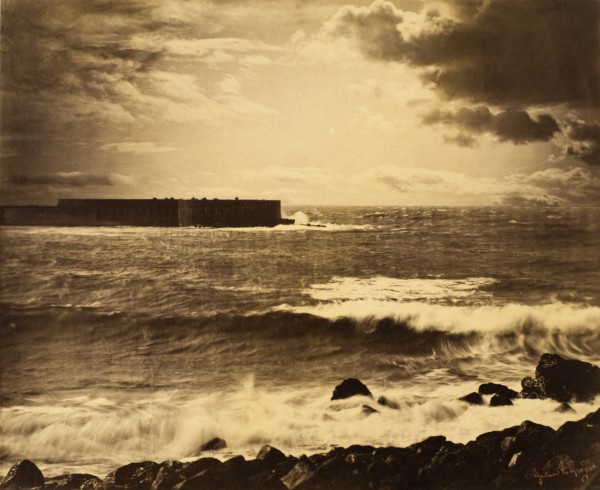
At bare minimum, the attraction of the Great Wave in 1999 had something to do with its representation of frenzy and impending crash. In reporting the sale in The New York Times, Souren Melikian provided what must now count as the standard late-twentieth-century description: “The albumen print conveys in beautiful tones of sepia brown and white the threatening atmosphere of the early stages of a tempest at sea. The storm is gathering at the left, already plunged in darkness, soon to be reinforced by huge clouds coming in from the right. The white glare of the froth crowning the waves in the foreground, the sharp black rocks emerging here and there, give the print a curious kinship to some of Courbet’s paintings.”3 Out of a frozen moment in time, the photograph is made to imply dynamic movement, transition, change. The punctuated comparison of Le Gray and Gustave Courbet only serves to emphasize and clarify these temporal concerns, concerns that have long informed our understanding of their relation.
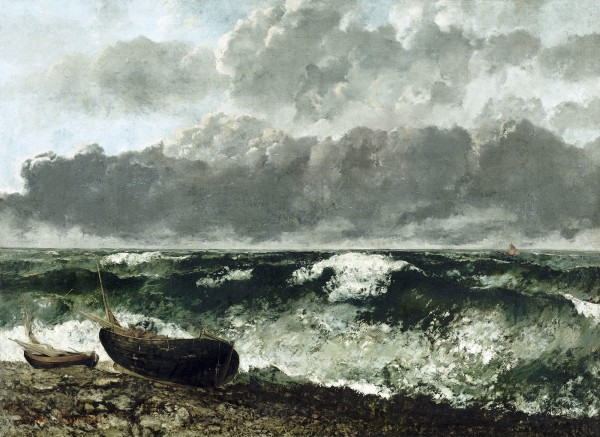
In December 1878, for example, the critic and art historian Paul Mantz sought to explain the limits of Realism’s adherence to the “strict truth of photography.” Taking Courbet’s Stormy Sea (The Wave) as exemplary, he pointed to the artist’s imaginative, if failed, attempt to “fix […] the moving image” of waves breaking on the shore and to “render such turbulent sights, so fugitive in their insistently changed shape.”4 (Fig. 2) The same month, the appearance of Eadweard Muybridge’s photographs of galloping horses in the French journal Nature opened the door to an instantaneous picture-making that could approach what, for Courbet, had been “impossible.”5 (Fig. 3)
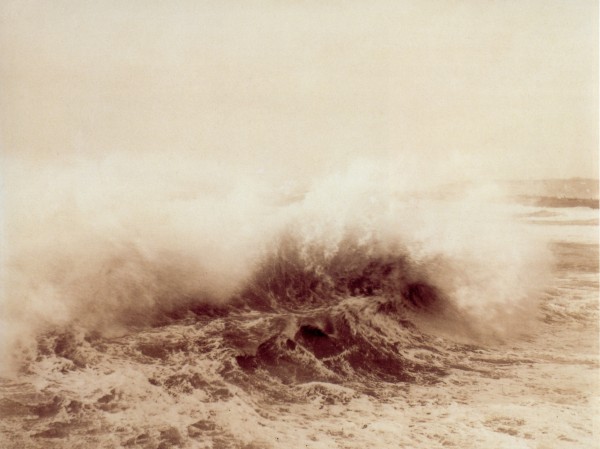
Ever since, Le Gray’s Great Wave, Sète has been folded into the wider visual culture of instantaneity. And rightly so, to an extent. It is, as I will argue here, a picture of an instant, and our ways of seeing easily recognize this. We are habituated to understanding how photographic images capture or represent passages of time, moments, that defy our own perceptual or phenomenological perception. A description such as Melikian’s rests precisely on a presumption of the coherence and consistency of the temporality represented in The Great Wave. It is a description, that is, attuned to photographic practices that emerged after 1878. To say, however, that Le Gray intended his photograph to be understood in 1857 as a representation of time, as a representation of instantaneousness, is to insist on a slightly different, but importantly different, set of assumptions about time and photography. Time, like photography itself, has a history and a philosophy, and this essay is a narrow and modest attempt to elaborate one strain of their conjunction.
Historical beholders of Le Gray’s photograph recognized its distinctive temporal concerns. The newspaper columnist Henry d’Audigier, for example, singled out The Great Wave for special attention in his published account of a visit to the photographer’s home in 1858. “There is a view of the Mediterranean taken opposite the city of Sète” he wrote in the July 25 issue of La Patrie, “the swells become fleecy in the distance, descend foaming toward the viewer and break like white powder on the rocks along the shore. Each wave is crowned by a little white puff whose every bitter drop we can count; on the edge of the picture, an enormous swell that breaks against a large black reef, is so well launched, so fast, so bubbly, that one would be tempted to step backward in order not to be touched by its furious momentum. The time it must have taken to observe and fix this little scene on glass is, so to speak, imperceptible: it’s 1/20th of a second. No one has yet achieved such a wonder of speed and dexterity.”6 The French words in this last phrase are promptitude and dextérité, which might also be translated as “rapidity” and “precision,” but either way the emphasis on the instantaneity of the image is clear.
Le Gray’s ability to capture such quickly passing scenes—to “instantaneously reproduce and fix” a “stormy sea”—had been noted before. The photographer’s one-time critic, François Moigno, for example, praised his seascapes in 1857 for offering the viewer “instantaneous pictures.”7 In general, it was immediately recognized how unprecedented the overall clarity and technical speed of the exposure must have been. Even early on, however, there were those who noted a certain artificial quality in Le Gray’s seascapes. An English critic found their light especially troubling, but bowed reluctantly to the general consensus. “It is a difficult matter,” the reviewer conceded, “to condemn as utterly untrue pictures to which universal praise is given to truthfulness.”8
The intuition of artificiality would be borne out ultimately by the posthumous revelation that Le Gray in fact produced The Great Wave, and several other prints around this time, using two negatives: one for the sea, and another one for the sky. Such combination printing went undetected at the time, and Le Gray never admitted it, but a close viewing of a print such as the one in the Vernon collection at LACMA gives some small but telling indications of the procedure: the seam between the negatives is just barely visible on the right side of the print. (Fig. 4)
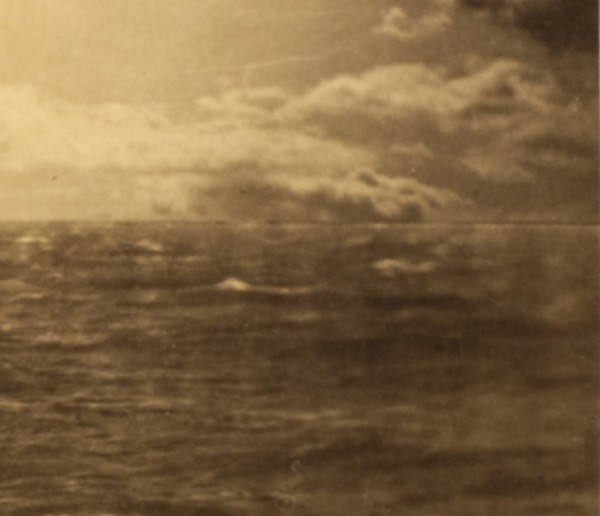
As any history of photography will tell you, this technique arose in response to the different exposure times required to capture the sea and sky when using wet collodion. This was not so much a problem of the different speeds of the passing clouds and the waves beneath them, but rather one having to do with the chemical sensitivity to light. Glass plates and exposure-times appropriate for a landscape would almost inevitably produce a kind of blotchiness in the sky. Consequently, as Mia Fineman and others have demonstrated, various techniques including combination printing and painting on the negative were used by landscape photographers until quite late in the nineteenth century.9 The standard account today of the technical and artistic innovation of The Great Wave is anchored in Le Gray’s ability to conceal the fact that this was a combination print and not a print made from a single exposure. For many of us today the picture no doubt succeeds in this respect.
In other prints, the facts of production are harder to deny. Photographs such as Seascape with a Ship Leaving Port and Large Wave, Mediterranean Sea, for example, show how Le Gray recycled certain negatives of the sky in a number of seascapes. (Figs. 5 & 6) These pictures are very closely related to the better-known image of Sète—the jetty in the Large Wave seems to be the same as in the foreground of the Great Wave—and they suggest that Le Gray tried a variety of combinations before considering any one of them a success. A juxtaposition of two such closely overlapping prints also makes the disjunction between sea and sky both more obvious and a more uncanny, as if the duplication of the clouds was a coincidence of nature rather than an intended and contrived construction. Or as if the unusually shaped cloud at right might also be a construct itself. In any case, they alert us more viscerally to the double-negative in The Great Wave.
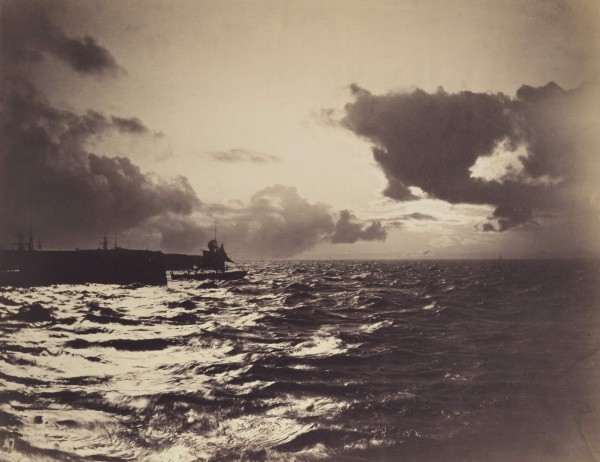
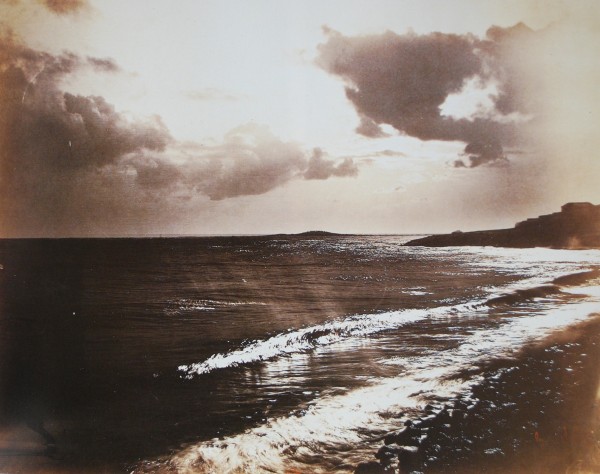
Despite or even because of this, we now know and in sense admire the combination printing of The Great Wave. Such techniques have been fully legitimized by certain tendencies in recent art photography—the late-twentieth century work of Jeff Wall comes immediately to mind. But for the historical viewers of Le Gray’s work, the construction of the image was not a salient part of the photograph. Even for later critics of combination printing like Peter Henry Emerson, double-negative printing in landscape photography was seen as a necessary compensation for the different exposures needed to capture a “naturalistic” image of both earth and sky.10 The Great Wave was no doubt seen as a unified and instantaneous picture. The core issue for any interpretation of the photograph, then, is how such instantaneousness was intended to be perceived. To understand such an historical phenomenology of beholding more broadly would require situating the emergence of new aesthetic forms like instantaneous photography in dialectical relation to the visuality that made them artistically possible and legible to their intended audiences.
The concept here of “visuality” might prove especially useful for an understanding of photographic temporality within a larger visual culture. “When we speak of visuality,” Whitney Davis explains, “rather than simply vision or visual perception, we address the difference introduced into human seeing by traditional cultural meaning consolidated and reconfigured in images.”11 The instantaneity of photography could have been recognized, that is, only to the extent it was comprehended in distinction from the duration and slowness found not only in earlier pictures, but within the broader economic and social structures then transforming the experience and understanding of time in the nineteenth century.12 Le Gray almost certainly intended The Great Wave to be understood as a unified image of time, of a passing instant. Yet, he had to manage the fact that such a photographic image was not technically possible, that knowledgeable viewers very well might understand the picture as not one but two separate moments.
Early descriptions of The Great Wave, like that of Henry d’Audigier, tend to linger on the foreground. The visual interest of the picture, as signaled by Le Gray’s title, has always been the photograph’s capture of the waves and swells crashing in what appears to be a split second—“1/20th of a second.” But the uptake of this imperceptible instant arises against the backdrop of stillness: the black breakwater on the left, the rocks in the foreground, the clouds in the sky. It is a rarely noted aspect of the photograph that the clouds are more clearly focused than the waves below. By the standards of visualization that later emerged, after 1878 most notably, the clouds are the more instantaneously rendered; the waves are unacceptably blurred. For obvious reasons, this blur registers as speed. Yet the assertion that the photograph captures the spray of water—“every bitter drop”—is largely fanciful, and more importantly it ignores the varying temporalities represented in the picture. The instantaneousness of the waves takes form only with and against the more durational time of the jetties and clouds.
While the use of the double-negative combination print can be understood to resolve a fairly common technical problem, it nonetheless created the all-but-indiscernible appearance of a double-time in The Great Wave. The difference between these times is made more dramatic, and importantly it is represented, as a result of the combination of two different negatives taken at different moments with different exposure times. As such, Le Gray, came to produce a picture of time that not only found wide admiration, but that continues to sit, unacknowledged, at the edge of a much-discussed issue in the history of photography: how does photography represent time? how does it figure the temporal nature of the medium? what kind of philosophy of time, if any, can be found in photography?
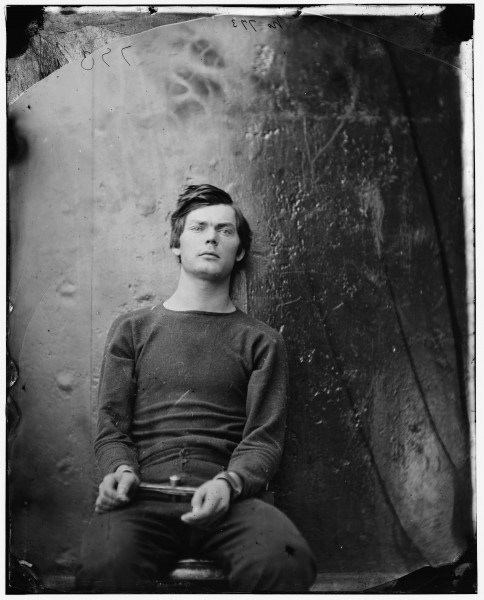
One prominent account of photography and time sails under the banner of the index. In a sense closely related to Honoré de Balzac’s belief that photographs physically transfer skin-like layers of reality, photographic theories of the index—or the trace, or the fossil—insist on the compressed temporal continuity of light hitting an object, entering a lens, and activating chemical (or digital) processes that result in the photographic image.13 And yet, as Kaja Silverman has rightly noted, “Discussions of photographic indexicality always focus on the past.”14 For Roland Barthes, famously, every photograph shows the “this-has-been.” In Alexander Gardner’s picture of the condemned conspirator Lewis Payne: “The photograph is handsome, as is the boy: that is the studium. But the punctum is: he is going to die.” (Fig. 7) All photographs ultimately, inevitably, offer a fossilization of the past, even as their persistence for us means there is “always a defeat of Time in them.”15
Michael Fried offers an important gloss of this line of thought about indexical temporality: “Time, in Barthes’s sense of the term, functions as a punctum for him precisely because the sense of something being past, being historical, cannot be perceived by the photographer or indeed anyone else in the present.”16 The special and pathos-ridden door the photograph opens to the past hinges on the beholder’s historical relation to the subject indexed by the camera. Our temporal distance from these men is what gives their portraits significance.17
The relative distance in time a person or event has to another person or event was characterized by the philosopher J. M. E. McTaggart in his famous 1908 essay “The Unreality of Time” as distinctive of what he called the B-Series.18 We can speak of something occurring two days earlier than, one day earlier than, simultaneous with and so on. This he opposes to the A-series, or: being two days future, being one day future, being present, being one day past. Few today agree with his conclusion that the contradiction in the A-series—namely, today cannot also be yesterday and tomorrow—means time is an illusion, but the related problem of the existence or nonexistence of the past remains a question with real (and largely unthought) applications to our understanding of photography. The vast majority of writing on photography presumes something like a presentist philosophy of time—photography captures a moment that now no longer exists (because only the present is real)—as opposed to an eternalist one that posits that the past (like the future) exists.19 At their most sophisticated, writers on photography have at least understood the strangeness of photography and time. For example, Ann Banfield puts the unspeakable tense of the photograph thus: “this was now here.”20
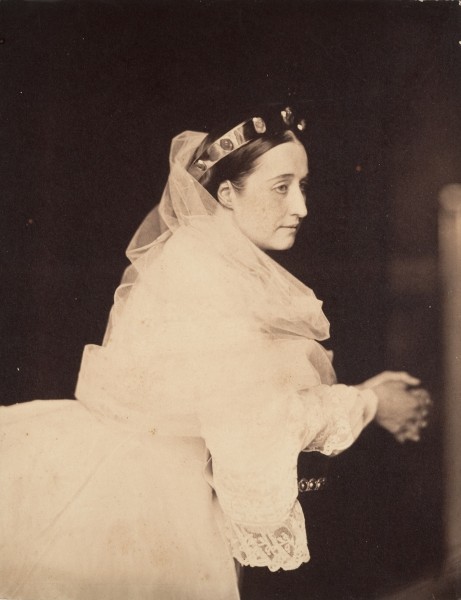
Le Gray arguably had some flickering awareness of these problems in photographic temporality. Like Nicéphore Nièpce before him, he had an early interest in using photography as a means of artistic reproduction. In 1848, he used a daguerreotype to trace, to index as precisely as possible the painting of Anacréon, Bacchus et l’Amour by his school-mate Jean-Léon Gérome. (They had both studied in Paul Delaroche’s studio). A bit later, Le Gray’s meteoric rise to success in the mid-1850s flowed from his ability to make beautiful photographs of prominent subjects of potentially historical significance. That his portraits of Empress Eugénie at Saint Cloud may have been done as studies for a never-completed painting by Thomas Couture only confirms the sense that they were made to be seen from a future, that is from a retrospective, historical standpoint. (Fig. 8) In large part, photography for Le Gray was intended to record the present for posterity. He certainly wasn’t alone in thinking this to be so. In April of 1857, at exactly the same moment that The Great Wave was exposed, Lady Elizabeth Eastlake asserted that “Every form that is traced by light is the impress of one moment, or one hour, or one age in the great passage of time.”21
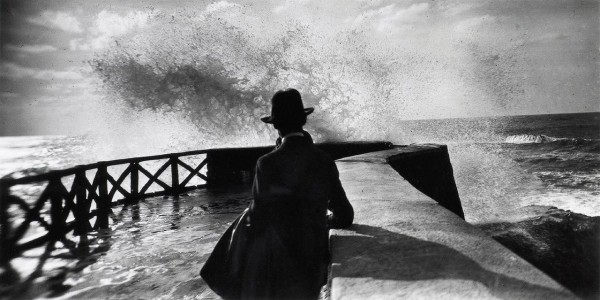
There are, of course, other ways of thinking about photographic temporality that do not rely so exclusively on the duration between photographic production and reception, on the “great passage of time.” The work of Jacques-Henri Lartigue offers countless images of instantaneousness, many of which are now of primarily historical interest. (Fig. 9) But unlike the indexical sense of inevitable pastness, they also provide an image of time that unsettles or makes strange our ordinary time perception. We are forced when looking at instantaneous photography to imagine what the nature of time might be if it can look like this. It heightens our awareness of what William James famously called “the specious present” or “the short duration of which we are immediately and incessantly sensible.”22 The interest here is the remarkable difference between photographic time and our own phenomenology of time consciousness.
Lartigue’s picture also crystallizes the way photographers, since the mid-nineteenth century have increasingly sought to manage the range of possible exposure times to produce a deliberate representation of time. Hence Henri Cartier-Bresson’s “decisive moment,” which for him relies on “the simultaneous recognition, in a fraction of a second, of the significance of an event as well as of a precise organization of forms which give the event its proper expression.”23 Or by contrast, Hiroshi Sugimoto’s 90-minute exposures of the interior of movie theaters, something he has half-jokingly called the “indecisive moment.”24 Between what the French call instantané and pose (snapshot and time-exposure), photographers have come to recognize the temporal component of the photographic medium as one of its defining characteristics.25
Le Gray certainly can be situated within the prehistory of instantaneous photography. My own interest in The Great Wave emerged from an inquiry into the discourse surrounding pictorial instantaneity prior to the publication of Muybridge’s famous split-second photographs of horses in 1878. It became clear that an extensive commentary on the problem and the promise of instantaneous photography dated back as early as 1841.26 Importantly, however, the definition of the term shifted from meaning something like an exposure of several seconds to meaning rather precisely any exposure-time less than 1/10 of a second after 1878—faster, that is, than the eye can see.27 For all its use and abuse in recent art historical writing, Walter Benjamin’s “optical unconscious” refers pretty specifically to this traversal of the perceptual horizon, in the visualization in “slow motion and enlargement” of “the fraction of a second when a person actually takes a step.”28 Or, when a wave crashes.
“In his famous painting, The Wave,” Benjamin wrote only a few years later, “a photographic subject is discovered through painting. In Courbet’s time, both the enlarged photo and the snapshot were unknown. His painting showed them the way. It equipped an expedition to explore a world of forms and structures which were not captured on the photographic plate until a decade later.”29 It has become such a commonplace in the art historical literature to see Le Gray lurking behind Courbet, to see him offering a model of a possible pictorial instantaneity, that we have lost hold of Benjamin’s more basic insight. That is, Courbet’s painting constituted only one part of a larger desire for pictorial instantaneity that photography could not then produce. Or more to the point—and here Benjamin is typically half-right—Courbet’s painting partly seeks to produce an emerging and still inchoate effect of pictorial instantaneousness, within and against a Realist concern with a slower and more durational time.
Le Gray too wished to produce such pictorial instantaneousness in his photography. Like the painter he was, he fully accepted the necessary fictitiousness of the resultant image, but the construction of a photograph of instantaneousness allowed him to realize a representation of time, properly speaking, that indeed would not be realized in photography for several decades. As such, The Great Wave might be said to offer a reflexivity about time that straight-forward instantaneous photography typically lacks. Or, that is, it relied on a constructedness, however successful its fictional coherence, that implicitly acknowledged the fictitiousness of its own representation of time. Why then, did Le Gray want to produce this image of time?
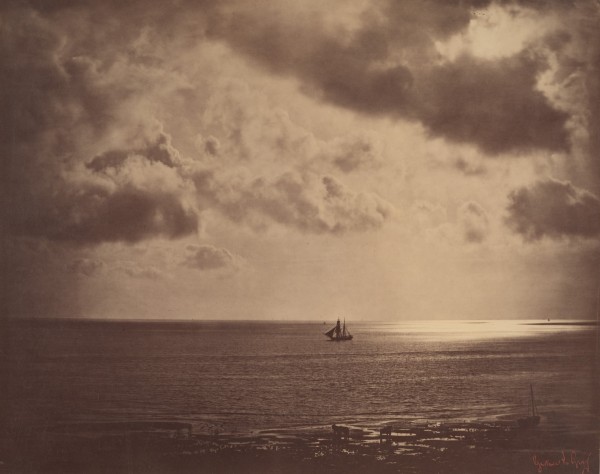
The Great Wave surfaced in the wake of another, once equally-famous seascape. Brig on the Water was a sensation when it first appeared at the Photographic Society of London in the fall of 1856. (Fig. 10) An advertisement in the British press reported that 800 copies of the print—it was then called Sea and Clouds—had been subscribed in only two months.30 Queen Victoria was among the buyers. Soon after, a French paper noted the photographer had already received orders worth 50,000 francs as a result of the exhibition.31 Gordon Baldwin has subsequently claimed that “for Europeans it was probably the most famous photographic image of the nineteenth century.”32 The enthusiasm for the photograph was also importantly tied up—for the first time—with the perceived instantaneity of the exposure. Not a combination print, the technical sleight of hand was replaced here with a titular one. Exposed in full sunlight, the photograph was shown in Paris as a moonlit scene.
In February of 1857, Brick au clair de lune was exhibited alongside a proof demonstrating its origin in an untouched negative at the Second Exhibit of the Société française de photographie. The show took place in Le Gray’s own studio at 35, boulevard de Capucines, an elaborate and expensive space he had acquired just over a year before with the financial backing of Barnabé Malbec de Montjoc, the Marquis de Briges, who fronted the 100,000 francs needed to incorporate Le Gray’s growing enterprise. Although a silent partner, the Marquis had apparently pressured the photographer to focus on his portrait business rather than his more personal concerns with landscape photography. The runaway success of the Brig on the Water seems to have encouraged Le Gray to keep at the subject, and to attempt to persuade the Marquis of its artistic and commercial significance.

Less than two months after the Paris exhibit, Le Gray found himself in the south of France. On April 2, he photographed the official opening of the new railroad connecting Toulouse and the port of Sète. Around this time, likely in the days that followed, he framed a number of views of the jetty and breakwater looking out to sea from the port. Back in Paris, these negatives were combined with others of the sky, possibly also made at Sète. The Breaking Wave is obviously a variant on The Great Wave. (Fig. 11) As Sylvie Aubenas has interestingly suggested, these photographs may have been produced as part of the renegotiations of the backing of Le Gray’s company following the unexpected death of the Marquis de Briges on April 17.33
In any case, these prints were two of only three that the photographer submitted to the French government for copyright protection in 1860, amid the bankruptcy and liquidation of his company. In other words, they mattered to him. Although obviously complementary pictures, their differences too are telling. Why, we might ask, is one so much more celebrated than the other? Part of the interest of The Great Wave compared even to The Breaking Wave is the way it brackets the relation of the port and the sea. It gives priority to the waves and the breakwater, but unlike most other seascapes, maybe especially painted ones, the place and scale of ships and the harbor are left decidedly vague. This is perhaps why it can be called the “great” wave. In fact, it is not actually a very large wave. But this is also why critics could zoom in on the photograph as an image of time. Given the photographer’s formal decision in The Great Wave to prioritize only the waves, the shore, the breakwater and the clouds in the sky, it is also part of the fabric of his intentions.
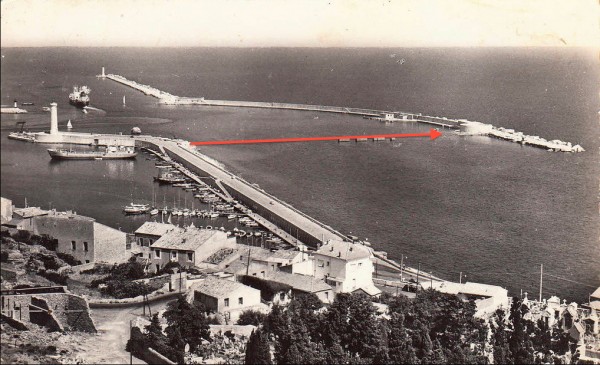
Le Gray’s motif is unusual within the iconography of the port of Sète. No other picture of the site, before or since, even comes close to that which is framed by The Great Wave. An annotated postcard shows both the more typical view and the likely position and direction of Le Gray’s camera in April 1857. (Fig. 12) Looking east from the hillside of the town itself, tourist views like this often show the entrance to the harbor, with its prominent breakwater on the right, but with the lay of the land and sea in full view. Given the details of ships, the photograph here seems to be a mid twentieth-century one. It is certainly well after 1879, when the breakwater at right was extended some distance to the east. (It has since been extended very far down the coast). None of these details are legible in The Great Wave.
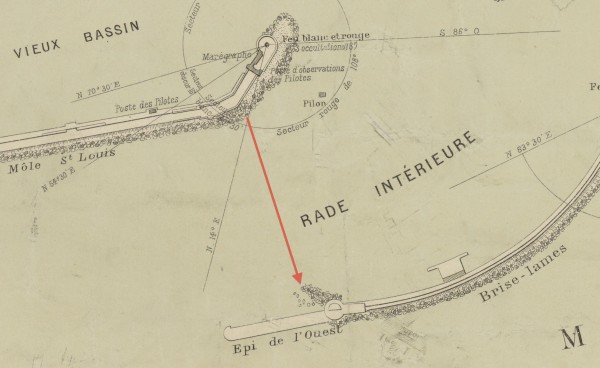
As the topography shows, the exposures Le Gray made in Sète were taken not from or of the port itself, but rather from the so-called môle Saint Louis, the jetty extending out from the town to the lighthouse. An annotated detail of a map from the early twentieth century makes this a bit clearer.34 (Fig. 13) Le Gray’s camera was thus pointed south across the western entrance of the harbor, a location that entirely brackets the port and harbor itself—and quite deliberately it would seem. Given the fame and ubiquity of The Great Wave, it can come as something of a surprise to discover the more precise location of the picture’s frame. Again, what this seems to suggest is that Le Gray sought out a motif that would resist the conventional view of the site in order to give priority to an image of the sea that would match or outdo the earlier success of the Brig on the Water. Cutting the ship out of the picture, so to speak, seemed the best procedure.
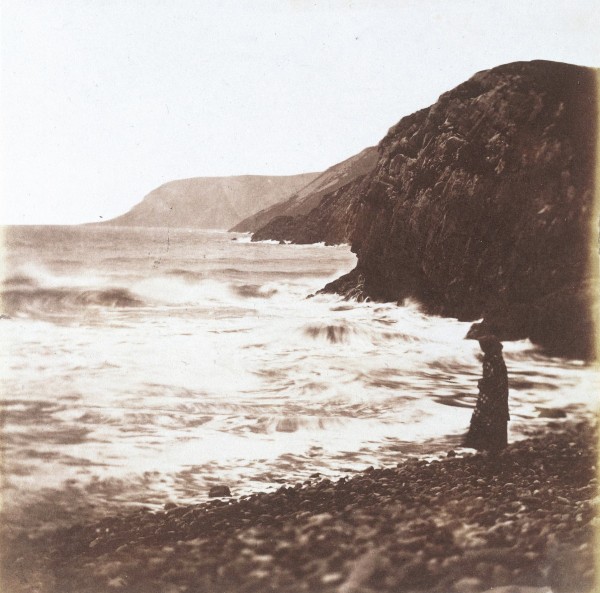
The Great Wave is not the first photograph to capture a breaking wave on the coast. The Welsh photographer John Dillwyn Llewelyn, a student of Henry Fox Talbot, had succeeded as early as 1853 in producing such print. (Fig. 14) Note, however, the sky: painted black in the negative, it has turned white in the print. Again, more than anything, the successful exposure of wave and cloud at the same time was Le Gray’s perceived accomplishment. He was precisely seeking to outdo such experiments in photographic time compression. Whether he actually saw Llewelyn’s photograph is irrelevant, as the discussion of such attempts was widespread in the French and English photographic press.
The same year, 1853, Ernest Lacan noted that Le Gray’s colleague Charles Nègre had produced a three-second exposure using the new wet-collodion process that was, as he put it, “practically instantaneous.”35 Although he remained a champion of the calotype, Le Gray had actually pioneered collodion photography and understood its necessity. Not only did it offer faster and faster exposure times—Muybridge himself used it in 1878—but it made combination printing considerably less arduous.
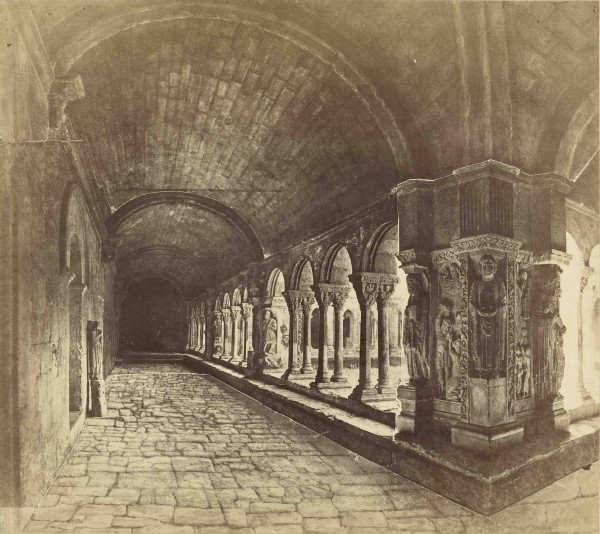
Le Gray, Nègre, and the German-born Edouard Baldus had all been members of the famous government-backed Mission Héliographiques in 1851. These photographers, each of whom was originally trained as a painter, were tasked at the time with documenting the architectural treasures of France. To manufacture his famous photograph of the Cloister of St. Trophîme, Arles Baldus made use of ten separate wax-paper negatives to produce the final print. (Fig. 15) Le Gray obviously knew of Baldus’s combination printing, and others such as their friend Hippolyte Bayard had also experimented with it, but for his part he never seems to have used it in his own calotypes. With the advent of the glass plate, however, the possibility of producing a crisp, coherent, instantaneous picture of the temporally complex visual world must have come to seem irresistible.
The word “collodion” shares an etymological origin with “collage.”36 What Le Gray invented in 1857 was a kind of temporal collage—the sea and the sky, the waves and the clouds, two times are placed edge to edge. The easiest way to see the resultant picture is as a harmonic synthesis of the two. Within the constraints of a nineteenth century visuality, this might have been the dominant way of perceiving The Great Wave. But the recognition of the artificiality of the process, the intuition that the suture did not quite hold, makes it possible to see a period significance to the temporal double-structure of the photograph.
Indeed, over the course of the nineteenth-century, two temporalities became increasingly recognizable in modernizing societies. The “lived time” of premodern and natural cycles oriented to the sun, the tides, the moon became the “measured time” of the clock and the workday, of shipping times and railroads connecting major cities. Although the conventional view would have it that speed and instantaneousness decisively came to dominate with the advent of the railroad and the telegraph, a deeper analysis indicates that only a small percentage in the nineteenth century felt the rigors of measured time decisively undoing an older, natural time. In the provinces of France, for instance, work in both the office and fields continued to operate under what Guy Thuillier has called the “ancien régime of time.”37 Pictorial instantaneity, then, in the work of Le Gray and Courbet alike, should be understood to have emerged from a visceral and ongoing cultural tension between older and newer temporalities. For whom, then, finally, would this tension have been legible?
The views of Sète were likely produced with one original and specific audience in mind: the Marquis de Briges and his heirs. The family came from a long line of aristocratic landowners in the Languedoc, but the marriage of Barnabé Louis Gabriel Charles Malbec de Montjoc to Marie-Barbe de Longaunay brought a large influx of new money.38 The Marquis and especially his sons sought to invest this new money in various risky new enterprises such as Le Gray’s photographic studio. To give another example of their investments, in the 1870s, the family got caught up in a legal conflict over a speculative property deal developing a hotel in Calaveras County, California, a case that ended up in the U.S. Supreme Court.39 The Malbec de Montjoc family were thus typical of a certain strain of wealthy European investors who sought to transition their fortune from the slower, more predictable returns from property and rent to the faster and less reliable speculative economy. For them, the tension between older and newer temporalities was their economic lifeblood.
In 1857, the speed of finance was reaching one of its periodic frenzy points. In France, the early phase of Haussmannization as well as a trade-deal with Britain brought a booming economy especially favorable to real estate and stock market speculation. On the steps of the Paris Bourse a flourishing market in “outside banking,” the so-called coulissiers, who made quick fortunes in unregulated futures and derivatives, were an increasing cause for concern. The French State introduced taxes on financial transactions later in the year, and in 1858 severely restricted the activities of the outside bankers.40 In the United States, the same booming economy came crashing down in September, with the famous Panic of 1857.41 The ripple-effect on the French economy was relatively short-lived, but widely noticed, not least on the stock exchange.42
This new speculative economy was built on and carried with it a new philosophy of time. As Thomas Piketty has shown, wealth accumulation in the nineteenth century was largely a matter of time, of simply waiting for predictable returns on investments. Rents and stock dividends provided income at an astonishingly steady rate of 4-5%. Inheritance flow maintained the steady rise of capital in the longue durée.43 But in what Piketty calls the “clash of temporalities,” this durational wealth expansion becomes almost invisible in the daily economy.44 It also fades from view in times of heightened financial speculation. In periods like the 1850s, “The belief in the value of lasting equilibrium and the well-defined object gave way to such values as mobility, flexibility, and a capacity to invent and adapt.” As Michel Melot has argued, this shift in the philosophy of capitalism occasioned a complete “revision of the notion of time.”45 Speculative stock trading, to say nothing of the sale of futures and derivatives, obtains its profit from the speed of transactions and the accuracy of predictions. In the nineteenth century nothing could be further from the property-owner’s own expectations of the economy of time. Both the landowning aristocrat and the speculative entrepreneur, then, adhered to a philosophy of time. But these philosophies were different, and these differences might very well be given representational form in the temporality of photography.
When the heirs to the fortune of the Marquis de Briges formally signed a new contract with Le Gray one month after the New York Stock Exchange plunged, sending ripples worldwide, they must have known the risks. And risks they were: within three years the business was bankrupt and Le Gray had sailed away—literally, first to Palermo, Italy, then to Egypt, where he died in the early 1880s. The reasons for the failure are not entirely clear. Nadar, who later came to occupy the studio at 35, boulevard de Capucines, claims in his memoir that the portrait business just could not be maintained in the face of the runaway success of Eugène Disderi’s carte-de-visite. “Le Gray,” he wrote, “could not resign himself to turn his studio into a factory; he gave up.”46
An important part of Le Gray’s ambition, then, in producing The Great Wave, Sète in early 1857, was to figure the tension between temporalities that both he and his financial backers were coming to recognize as the structural condition of their world. For Le Gray himself, the “industrial madness” of late-1850s photography came to force his practice into another realm of economic production, one whose speed and mechanization he ultimately resisted altogether. But in 1857, a compromise formation between the instantaneousness of the glass-plate negative and the constructed—indeed collaged—print that fictionalized that same instantaneousness seemed possible, if not downright necessary. Its ultimate legibility as a multivalent temporal register remains a matter of interpretation. But as such, the The Great Wave offers not only a implicit critical reflection on time in the nineteenth century, but on the very possibility of its representation in photography.
Notes
My thanks for feedback from the participants and audience who heard this paper at the “Photography and Philosophy” conference at LACMA in March 2015. Comments from Tim Clark and Walter Benn Michaels were especially productive in the revision process. My wife, Gabrielle Larocque, helped me find the time to write and rewrite this essay.
All translations are mine unless otherwise indicated.
Notes
“See also Sylvie Aubenas, “From One Century to the Next: The Fate of Le Gray’s Work in Photographic Collections,” in Aubenas, Gustave Le Gray, 1820–1884 (Los Angeles: The J. Paul Getty Museum, 2002), 323.
Although surprisingly little has been written about it, Gustave Le Gray’s Great Wave, Sète of 1857 has acquired canonical status in the history of photography. (Fig. 1) The picture’s contemporary fame reached a high-water mark in October 1999 when a print from the collection of André and Marie-Thérèse Jammes sold at Sotheby’s London for a then-record £507,500.1 That its maximum appeal coincided with a period of elevated stock-market speculation—only two months later the FTSE 100 reached an historic apex2—may appear at first glance insignificant to any historical understanding of Le Gray’s work. Admittedly, it must be considered a mere coincidence that the print itself was produced at an analogous moment of financial frenzy. But the coincidence is, I hope to show, a telling one.

At bare minimum, the attraction of the Great Wave in 1999 had something to do with its representation of frenzy and impending crash. In reporting the sale in The New York Times, Souren Melikian provided what must now count as the standard late-twentieth-century description: “The albumen print conveys in beautiful tones of sepia brown and white the threatening atmosphere of the early stages of a tempest at sea. The storm is gathering at the left, already plunged in darkness, soon to be reinforced by huge clouds coming in from the right. The white glare of the froth crowning the waves in the foreground, the sharp black rocks emerging here and there, give the print a curious kinship to some of Courbet’s paintings.”3 Out of a frozen moment in time, the photograph is made to imply dynamic movement, transition, change. The punctuated comparison of Le Gray and Gustave Courbet only serves to emphasize and clarify these temporal concerns, concerns that have long informed our understanding of their relation.

In December 1878, for example, the critic and art historian Paul Mantz sought to explain the limits of Realism’s adherence to the “strict truth of photography.” Taking Courbet’s Stormy Sea (The Wave) as exemplary, he pointed to the artist’s imaginative, if failed, attempt to “fix […] the moving image” of waves breaking on the shore and to “render such turbulent sights, so fugitive in their insistently changed shape.”4 (Fig. 2) The same month, the appearance of Eadweard Muybridge’s photographs of galloping horses in the French journal Nature opened the door to an instantaneous picture-making that could approach what, for Courbet, had been “impossible.”5 (Fig. 3)

Ever since, Le Gray’s Great Wave, Sète has been folded into the wider visual culture of instantaneity. And rightly so, to an extent. It is, as I will argue here, a picture of an instant, and our ways of seeing easily recognize this. We are habituated to understanding how photographic images capture or represent passages of time, moments, that defy our own perceptual or phenomenological perception. A description such as Melikian’s rests precisely on a presumption of the coherence and consistency of the temporality represented in The Great Wave. It is a description, that is, attuned to photographic practices that emerged after 1878. To say, however, that Le Gray intended his photograph to be understood in 1857 as a representation of time, as a representation of instantaneousness, is to insist on a slightly different, but importantly different, set of assumptions about time and photography. Time, like photography itself, has a history and a philosophy, and this essay is a narrow and modest attempt to elaborate one strain of their conjunction.
Historical beholders of Le Gray’s photograph recognized its distinctive temporal concerns. The newspaper columnist Henry d’Audigier, for example, singled out The Great Wave for special attention in his published account of a visit to the photographer’s home in 1858. “There is a view of the Mediterranean taken opposite the city of Sète” he wrote in the July 25 issue of La Patrie, “the swells become fleecy in the distance, descend foaming toward the viewer and break like white powder on the rocks along the shore. Each wave is crowned by a little white puff whose every bitter drop we can count; on the edge of the picture, an enormous swell that breaks against a large black reef, is so well launched, so fast, so bubbly, that one would be tempted to step backward in order not to be touched by its furious momentum. The time it must have taken to observe and fix this little scene on glass is, so to speak, imperceptible: it’s 1/20th of a second. No one has yet achieved such a wonder of speed and dexterity.”6 The French words in this last phrase are promptitude and dextérité, which might also be translated as “rapidity” and “precision,” but either way the emphasis on the instantaneity of the image is clear.
Le Gray’s ability to capture such quickly passing scenes—to “instantaneously reproduce and fix” a “stormy sea”—had been noted before. The photographer’s one-time critic, François Moigno, for example, praised his seascapes in 1857 for offering the viewer “instantaneous pictures.”7 In general, it was immediately recognized how unprecedented the overall clarity and technical speed of the exposure must have been. Even early on, however, there were those who noted a certain artificial quality in Le Gray’s seascapes. An English critic found their light especially troubling, but bowed reluctantly to the general consensus. “It is a difficult matter,” the reviewer conceded, “to condemn as utterly untrue pictures to which universal praise is given to truthfulness.”8
The intuition of artificiality would be borne out ultimately by the posthumous revelation that Le Gray in fact produced The Great Wave, and several other prints around this time, using two negatives: one for the sea, and another one for the sky. Such combination printing went undetected at the time, and Le Gray never admitted it, but a close viewing of a print such as the one in the Vernon collection at LACMA gives some small but telling indications of the procedure: the seam between the negatives is just barely visible on the right side of the print. (Fig. 4)

As any history of photography will tell you, this technique arose in response to the different exposure times required to capture the sea and sky when using wet collodion. This was not so much a problem of the different speeds of the passing clouds and the waves beneath them, but rather one having to do with the chemical sensitivity to light. Glass plates and exposure-times appropriate for a landscape would almost inevitably produce a kind of blotchiness in the sky. Consequently, as Mia Fineman and others have demonstrated, various techniques including combination printing and painting on the negative were used by landscape photographers until quite late in the nineteenth century.9 The standard account today of the technical and artistic innovation of The Great Wave is anchored in Le Gray’s ability to conceal the fact that this was a combination print and not a print made from a single exposure. For many of us today the picture no doubt succeeds in this respect.
In other prints, the facts of production are harder to deny. Photographs such as Seascape with a Ship Leaving Port and Large Wave, Mediterranean Sea, for example, show how Le Gray recycled certain negatives of the sky in a number of seascapes. (Figs. 5 & 6) These pictures are very closely related to the better-known image of Sète—the jetty in the Large Wave seems to be the same as in the foreground of the Great Wave—and they suggest that Le Gray tried a variety of combinations before considering any one of them a success. A juxtaposition of two such closely overlapping prints also makes the disjunction between sea and sky both more obvious and a more uncanny, as if the duplication of the clouds was a coincidence of nature rather than an intended and contrived construction. Or as if the unusually shaped cloud at right might also be a construct itself. In any case, they alert us more viscerally to the double-negative in The Great Wave.


Despite or even because of this, we now know and in sense admire the combination printing of The Great Wave. Such techniques have been fully legitimized by certain tendencies in recent art photography—the late-twentieth century work of Jeff Wall comes immediately to mind. But for the historical viewers of Le Gray’s work, the construction of the image was not a salient part of the photograph. Even for later critics of combination printing like Peter Henry Emerson, double-negative printing in landscape photography was seen as a necessary compensation for the different exposures needed to capture a “naturalistic” image of both earth and sky.10 The Great Wave was no doubt seen as a unified and instantaneous picture. The core issue for any interpretation of the photograph, then, is how such instantaneousness was intended to be perceived. To understand such an historical phenomenology of beholding more broadly would require situating the emergence of new aesthetic forms like instantaneous photography in dialectical relation to the visuality that made them artistically possible and legible to their intended audiences.
The concept here of “visuality” might prove especially useful for an understanding of photographic temporality within a larger visual culture. “When we speak of visuality,” Whitney Davis explains, “rather than simply vision or visual perception, we address the difference introduced into human seeing by traditional cultural meaning consolidated and reconfigured in images.”11 The instantaneity of photography could have been recognized, that is, only to the extent it was comprehended in distinction from the duration and slowness found not only in earlier pictures, but within the broader economic and social structures then transforming the experience and understanding of time in the nineteenth century.12 Le Gray almost certainly intended The Great Wave to be understood as a unified image of time, of a passing instant. Yet, he had to manage the fact that such a photographic image was not technically possible, that knowledgeable viewers very well might understand the picture as not one but two separate moments.
Early descriptions of The Great Wave, like that of Henry d’Audigier, tend to linger on the foreground. The visual interest of the picture, as signaled by Le Gray’s title, has always been the photograph’s capture of the waves and swells crashing in what appears to be a split second—“1/20th of a second.” But the uptake of this imperceptible instant arises against the backdrop of stillness: the black breakwater on the left, the rocks in the foreground, the clouds in the sky. It is a rarely noted aspect of the photograph that the clouds are more clearly focused than the waves below. By the standards of visualization that later emerged, after 1878 most notably, the clouds are the more instantaneously rendered; the waves are unacceptably blurred. For obvious reasons, this blur registers as speed. Yet the assertion that the photograph captures the spray of water—“every bitter drop”—is largely fanciful, and more importantly it ignores the varying temporalities represented in the picture. The instantaneousness of the waves takes form only with and against the more durational time of the jetties and clouds.
While the use of the double-negative combination print can be understood to resolve a fairly common technical problem, it nonetheless created the all-but-indiscernible appearance of a double-time in The Great Wave. The difference between these times is made more dramatic, and importantly it is represented, as a result of the combination of two different negatives taken at different moments with different exposure times. As such, Le Gray, came to produce a picture of time that not only found wide admiration, but that continues to sit, unacknowledged, at the edge of a much-discussed issue in the history of photography: how does photography represent time? how does it figure the temporal nature of the medium? what kind of philosophy of time, if any, can be found in photography?

One prominent account of photography and time sails under the banner of the index. In a sense closely related to Honoré de Balzac’s belief that photographs physically transfer skin-like layers of reality, photographic theories of the index—or the trace, or the fossil—insist on the compressed temporal continuity of light hitting an object, entering a lens, and activating chemical (or digital) processes that result in the photographic image.13 And yet, as Kaja Silverman has rightly noted, “Discussions of photographic indexicality always focus on the past.”14 For Roland Barthes, famously, every photograph shows the “this-has-been.” In Alexander Gardner’s picture of the condemned conspirator Lewis Payne: “The photograph is handsome, as is the boy: that is the studium. But the punctum is: he is going to die.” (Fig. 7) All photographs ultimately, inevitably, offer a fossilization of the past, even as their persistence for us means there is “always a defeat of Time in them.”15
Michael Fried offers an important gloss of this line of thought about indexical temporality: “Time, in Barthes’s sense of the term, functions as a punctum for him precisely because the sense of something being past, being historical, cannot be perceived by the photographer or indeed anyone else in the present.”16 The special and pathos-ridden door the photograph opens to the past hinges on the beholder’s historical relation to the subject indexed by the camera. Our temporal distance from these men is what gives their portraits significance.17
The relative distance in time a person or event has to another person or event was characterized by the philosopher J. M. E. McTaggart in his famous 1908 essay “The Unreality of Time” as distinctive of what he called the B-Series.18 We can speak of something occurring two days earlier than, one day earlier than, simultaneous with and so on. This he opposes to the A-series, or: being two days future, being one day future, being present, being one day past. Few today agree with his conclusion that the contradiction in the A-series—namely, today cannot also be yesterday and tomorrow—means time is an illusion, but the related problem of the existence or nonexistence of the past remains a question with real (and largely unthought) applications to our understanding of photography. The vast majority of writing on photography presumes something like a presentist philosophy of time—photography captures a moment that now no longer exists (because only the present is real)—as opposed to an eternalist one that posits that the past (like the future) exists.19 At their most sophisticated, writers on photography have at least understood the strangeness of photography and time. For example, Ann Banfield puts the unspeakable tense of the photograph thus: “this was now here.”20

Le Gray arguably had some flickering awareness of these problems in photographic temporality. Like Nicéphore Nièpce before him, he had an early interest in using photography as a means of artistic reproduction. In 1848, he used a daguerreotype to trace, to index as precisely as possible the painting of Anacréon, Bacchus et l’Amour by his school-mate Jean-Léon Gérome. (They had both studied in Paul Delaroche’s studio). A bit later, Le Gray’s meteoric rise to success in the mid-1850s flowed from his ability to make beautiful photographs of prominent subjects of potentially historical significance. That his portraits of Empress Eugénie at Saint Cloud may have been done as studies for a never-completed painting by Thomas Couture only confirms the sense that they were made to be seen from a future, that is from a retrospective, historical standpoint. (Fig. 8) In large part, photography for Le Gray was intended to record the present for posterity. He certainly wasn’t alone in thinking this to be so. In April of 1857, at exactly the same moment that The Great Wave was exposed, Lady Elizabeth Eastlake asserted that “Every form that is traced by light is the impress of one moment, or one hour, or one age in the great passage of time.”21

There are, of course, other ways of thinking about photographic temporality that do not rely so exclusively on the duration between photographic production and reception, on the “great passage of time.” The work of Jacques-Henri Lartigue offers countless images of instantaneousness, many of which are now of primarily historical interest. (Fig. 9) But unlike the indexical sense of inevitable pastness, they also provide an image of time that unsettles or makes strange our ordinary time perception. We are forced when looking at instantaneous photography to imagine what the nature of time might be if it can look like this. It heightens our awareness of what William James famously called “the specious present” or “the short duration of which we are immediately and incessantly sensible.”22 The interest here is the remarkable difference between photographic time and our own phenomenology of time consciousness.
Lartigue’s picture also crystallizes the way photographers, since the mid-nineteenth century have increasingly sought to manage the range of possible exposure times to produce a deliberate representation of time. Hence Henri Cartier-Bresson’s “decisive moment,” which for him relies on “the simultaneous recognition, in a fraction of a second, of the significance of an event as well as of a precise organization of forms which give the event its proper expression.”23 Or by contrast, Hiroshi Sugimoto’s 90-minute exposures of the interior of movie theaters, something he has half-jokingly called the “indecisive moment.”24 Between what the French call instantané and pose (snapshot and time-exposure), photographers have come to recognize the temporal component of the photographic medium as one of its defining characteristics.25
Le Gray certainly can be situated within the prehistory of instantaneous photography. My own interest in The Great Wave emerged from an inquiry into the discourse surrounding pictorial instantaneity prior to the publication of Muybridge’s famous split-second photographs of horses in 1878. It became clear that an extensive commentary on the problem and the promise of instantaneous photography dated back as early as 1841.26 Importantly, however, the definition of the term shifted from meaning something like an exposure of several seconds to meaning rather precisely any exposure-time less than 1/10 of a second after 1878—faster, that is, than the eye can see.27 For all its use and abuse in recent art historical writing, Walter Benjamin’s “optical unconscious” refers pretty specifically to this traversal of the perceptual horizon, in the visualization in “slow motion and enlargement” of “the fraction of a second when a person actually takes a step.”28 Or, when a wave crashes.
“In his famous painting, The Wave,” Benjamin wrote only a few years later, “a photographic subject is discovered through painting. In Courbet’s time, both the enlarged photo and the snapshot were unknown. His painting showed them the way. It equipped an expedition to explore a world of forms and structures which were not captured on the photographic plate until a decade later.”29 It has become such a commonplace in the art historical literature to see Le Gray lurking behind Courbet, to see him offering a model of a possible pictorial instantaneity, that we have lost hold of Benjamin’s more basic insight. That is, Courbet’s painting constituted only one part of a larger desire for pictorial instantaneity that photography could not then produce. Or more to the point—and here Benjamin is typically half-right—Courbet’s painting partly seeks to produce an emerging and still inchoate effect of pictorial instantaneousness, within and against a Realist concern with a slower and more durational time.
Le Gray too wished to produce such pictorial instantaneousness in his photography. Like the painter he was, he fully accepted the necessary fictitiousness of the resultant image, but the construction of a photograph of instantaneousness allowed him to realize a representation of time, properly speaking, that indeed would not be realized in photography for several decades. As such, The Great Wave might be said to offer a reflexivity about time that straight-forward instantaneous photography typically lacks. Or, that is, it relied on a constructedness, however successful its fictional coherence, that implicitly acknowledged the fictitiousness of its own representation of time. Why then, did Le Gray want to produce this image of time?

The Great Wave surfaced in the wake of another, once equally-famous seascape. Brig on the Water was a sensation when it first appeared at the Photographic Society of London in the fall of 1856. (Fig. 10) An advertisement in the British press reported that 800 copies of the print—it was then called Sea and Clouds—had been subscribed in only two months.30 Queen Victoria was among the buyers. Soon after, a French paper noted the photographer had already received orders worth 50,000 francs as a result of the exhibition.31 Gordon Baldwin has subsequently claimed that “for Europeans it was probably the most famous photographic image of the nineteenth century.”32 The enthusiasm for the photograph was also importantly tied up—for the first time—with the perceived instantaneity of the exposure. Not a combination print, the technical sleight of hand was replaced here with a titular one. Exposed in full sunlight, the photograph was shown in Paris as a moonlit scene.
In February of 1857, Brick au clair de lune was exhibited alongside a proof demonstrating its origin in an untouched negative at the Second Exhibit of the Société française de photographie. The show took place in Le Gray’s own studio at 35, boulevard de Capucines, an elaborate and expensive space he had acquired just over a year before with the financial backing of Barnabé Malbec de Montjoc, the Marquis de Briges, who fronted the 100,000 francs needed to incorporate Le Gray’s growing enterprise. Although a silent partner, the Marquis had apparently pressured the photographer to focus on his portrait business rather than his more personal concerns with landscape photography. The runaway success of the Brig on the Water seems to have encouraged Le Gray to keep at the subject, and to attempt to persuade the Marquis of its artistic and commercial significance.

Less than two months after the Paris exhibit, Le Gray found himself in the south of France. On April 2, he photographed the official opening of the new railroad connecting Toulouse and the port of Sète. Around this time, likely in the days that followed, he framed a number of views of the jetty and breakwater looking out to sea from the port. Back in Paris, these negatives were combined with others of the sky, possibly also made at Sète. The Breaking Wave is obviously a variant on The Great Wave. (Fig. 11) As Sylvie Aubenas has interestingly suggested, these photographs may have been produced as part of the renegotiations of the backing of Le Gray’s company following the unexpected death of the Marquis de Briges on April 17.33
In any case, these prints were two of only three that the photographer submitted to the French government for copyright protection in 1860, amid the bankruptcy and liquidation of his company. In other words, they mattered to him. Although obviously complementary pictures, their differences too are telling. Why, we might ask, is one so much more celebrated than the other? Part of the interest of The Great Wave compared even to The Breaking Wave is the way it brackets the relation of the port and the sea. It gives priority to the waves and the breakwater, but unlike most other seascapes, maybe especially painted ones, the place and scale of ships and the harbor are left decidedly vague. This is perhaps why it can be called the “great” wave. In fact, it is not actually a very large wave. But this is also why critics could zoom in on the photograph as an image of time. Given the photographer’s formal decision in The Great Wave to prioritize only the waves, the shore, the breakwater and the clouds in the sky, it is also part of the fabric of his intentions.

Le Gray’s motif is unusual within the iconography of the port of Sète. No other picture of the site, before or since, even comes close to that which is framed by The Great Wave. An annotated postcard shows both the more typical view and the likely position and direction of Le Gray’s camera in April 1857. (Fig. 12) Looking east from the hillside of the town itself, tourist views like this often show the entrance to the harbor, with its prominent breakwater on the right, but with the lay of the land and sea in full view. Given the details of ships, the photograph here seems to be a mid twentieth-century one. It is certainly well after 1879, when the breakwater at right was extended some distance to the east. (It has since been extended very far down the coast). None of these details are legible in The Great Wave.

As the topography shows, the exposures Le Gray made in Sète were taken not from or of the port itself, but rather from the so-called môle Saint Louis, the jetty extending out from the town to the lighthouse. An annotated detail of a map from the early twentieth century makes this a bit clearer.34 (Fig. 13) Le Gray’s camera was thus pointed south across the western entrance of the harbor, a location that entirely brackets the port and harbor itself—and quite deliberately it would seem. Given the fame and ubiquity of The Great Wave, it can come as something of a surprise to discover the more precise location of the picture’s frame. Again, what this seems to suggest is that Le Gray sought out a motif that would resist the conventional view of the site in order to give priority to an image of the sea that would match or outdo the earlier success of the Brig on the Water. Cutting the ship out of the picture, so to speak, seemed the best procedure.

The Great Wave is not the first photograph to capture a breaking wave on the coast. The Welsh photographer John Dillwyn Llewelyn, a student of Henry Fox Talbot, had succeeded as early as 1853 in producing such print. (Fig. 14) Note, however, the sky: painted black in the negative, it has turned white in the print. Again, more than anything, the successful exposure of wave and cloud at the same time was Le Gray’s perceived accomplishment. He was precisely seeking to outdo such experiments in photographic time compression. Whether he actually saw Llewelyn’s photograph is irrelevant, as the discussion of such attempts was widespread in the French and English photographic press.
The same year, 1853, Ernest Lacan noted that Le Gray’s colleague Charles Nègre had produced a three-second exposure using the new wet-collodion process that was, as he put it, “practically instantaneous.”35 Although he remained a champion of the calotype, Le Gray had actually pioneered collodion photography and understood its necessity. Not only did it offer faster and faster exposure times—Muybridge himself used it in 1878—but it made combination printing considerably less arduous.

Le Gray, Nègre, and the German-born Edouard Baldus had all been members of the famous government-backed Mission Héliographiques in 1851. These photographers, each of whom was originally trained as a painter, were tasked at the time with documenting the architectural treasures of France. To manufacture his famous photograph of the Cloister of St. Trophîme, Arles Baldus made use of ten separate wax-paper negatives to produce the final print. (Fig. 15) Le Gray obviously knew of Baldus’s combination printing, and others such as their friend Hippolyte Bayard had also experimented with it, but for his part he never seems to have used it in his own calotypes. With the advent of the glass plate, however, the possibility of producing a crisp, coherent, instantaneous picture of the temporally complex visual world must have come to seem irresistible.
The word “collodion” shares an etymological origin with “collage.”36 What Le Gray invented in 1857 was a kind of temporal collage—the sea and the sky, the waves and the clouds, two times are placed edge to edge. The easiest way to see the resultant picture is as a harmonic synthesis of the two. Within the constraints of a nineteenth century visuality, this might have been the dominant way of perceiving The Great Wave. But the recognition of the artificiality of the process, the intuition that the suture did not quite hold, makes it possible to see a period significance to the temporal double-structure of the photograph.
Indeed, over the course of the nineteenth-century, two temporalities became increasingly recognizable in modernizing societies. The “lived time” of premodern and natural cycles oriented to the sun, the tides, the moon became the “measured time” of the clock and the workday, of shipping times and railroads connecting major cities. Although the conventional view would have it that speed and instantaneousness decisively came to dominate with the advent of the railroad and the telegraph, a deeper analysis indicates that only a small percentage in the nineteenth century felt the rigors of measured time decisively undoing an older, natural time. In the provinces of France, for instance, work in both the office and fields continued to operate under what Guy Thuillier has called the “ancien régime of time.”37 Pictorial instantaneity, then, in the work of Le Gray and Courbet alike, should be understood to have emerged from a visceral and ongoing cultural tension between older and newer temporalities. For whom, then, finally, would this tension have been legible?
The views of Sète were likely produced with one original and specific audience in mind: the Marquis de Briges and his heirs. The family came from a long line of aristocratic landowners in the Languedoc, but the marriage of Barnabé Louis Gabriel Charles Malbec de Montjoc to Marie-Barbe de Longaunay brought a large influx of new money.38 The Marquis and especially his sons sought to invest this new money in various risky new enterprises such as Le Gray’s photographic studio. To give another example of their investments, in the 1870s, the family got caught up in a legal conflict over a speculative property deal developing a hotel in Calaveras County, California, a case that ended up in the U.S. Supreme Court.39 The Malbec de Montjoc family were thus typical of a certain strain of wealthy European investors who sought to transition their fortune from the slower, more predictable returns from property and rent to the faster and less reliable speculative economy. For them, the tension between older and newer temporalities was their economic lifeblood.
In 1857, the speed of finance was reaching one of its periodic frenzy points. In France, the early phase of Haussmannization as well as a trade-deal with Britain brought a booming economy especially favorable to real estate and stock market speculation. On the steps of the Paris Bourse a flourishing market in “outside banking,” the so-called coulissiers, who made quick fortunes in unregulated futures and derivatives, were an increasing cause for concern. The French State introduced taxes on financial transactions later in the year, and in 1858 severely restricted the activities of the outside bankers.40 In the United States, the same booming economy came crashing down in September, with the famous Panic of 1857.41 The ripple-effect on the French economy was relatively short-lived, but widely noticed, not least on the stock exchange.42
This new speculative economy was built on and carried with it a new philosophy of time. As Thomas Piketty has shown, wealth accumulation in the nineteenth century was largely a matter of time, of simply waiting for predictable returns on investments. Rents and stock dividends provided income at an astonishingly steady rate of 4-5%. Inheritance flow maintained the steady rise of capital in the longue durée.43 But in what Piketty calls the “clash of temporalities,” this durational wealth expansion becomes almost invisible in the daily economy.44 It also fades from view in times of heightened financial speculation. In periods like the 1850s, “The belief in the value of lasting equilibrium and the well-defined object gave way to such values as mobility, flexibility, and a capacity to invent and adapt.” As Michel Melot has argued, this shift in the philosophy of capitalism occasioned a complete “revision of the notion of time.”45 Speculative stock trading, to say nothing of the sale of futures and derivatives, obtains its profit from the speed of transactions and the accuracy of predictions. In the nineteenth century nothing could be further from the property-owner’s own expectations of the economy of time. Both the landowning aristocrat and the speculative entrepreneur, then, adhered to a philosophy of time. But these philosophies were different, and these differences might very well be given representational form in the temporality of photography.
When the heirs to the fortune of the Marquis de Briges formally signed a new contract with Le Gray one month after the New York Stock Exchange plunged, sending ripples worldwide, they must have known the risks. And risks they were: within three years the business was bankrupt and Le Gray had sailed away—literally, first to Palermo, Italy, then to Egypt, where he died in the early 1880s. The reasons for the failure are not entirely clear. Nadar, who later came to occupy the studio at 35, boulevard de Capucines, claims in his memoir that the portrait business just could not be maintained in the face of the runaway success of Eugène Disderi’s carte-de-visite. “Le Gray,” he wrote, “could not resign himself to turn his studio into a factory; he gave up.”46
An important part of Le Gray’s ambition, then, in producing The Great Wave, Sète in early 1857, was to figure the tension between temporalities that both he and his financial backers were coming to recognize as the structural condition of their world. For Le Gray himself, the “industrial madness” of late-1850s photography came to force his practice into another realm of economic production, one whose speed and mechanization he ultimately resisted altogether. But in 1857, a compromise formation between the instantaneousness of the glass-plate negative and the constructed—indeed collaged—print that fictionalized that same instantaneousness seemed possible, if not downright necessary. Its ultimate legibility as a multivalent temporal register remains a matter of interpretation. But as such, the The Great Wave offers not only a implicit critical reflection on time in the nineteenth century, but on the very possibility of its representation in photography.
Notes
My thanks for feedback from the participants and audience who heard this paper at the “Photography and Philosophy” conference at LACMA in March 2015. Comments from Tim Clark and Walter Benn Michaels were especially productive in the revision process. My wife, Gabrielle Larocque, helped me find the time to write and rewrite this essay.
All translations are mine unless otherwise indicated.
Notes
“See also Sylvie Aubenas, “From One Century to the Next: The Fate of Le Gray’s Work in Photographic Collections,” in Aubenas, Gustave Le Gray, 1820–1884 (Los Angeles: The J. Paul Getty Museum, 2002), 323.